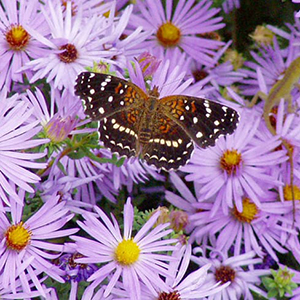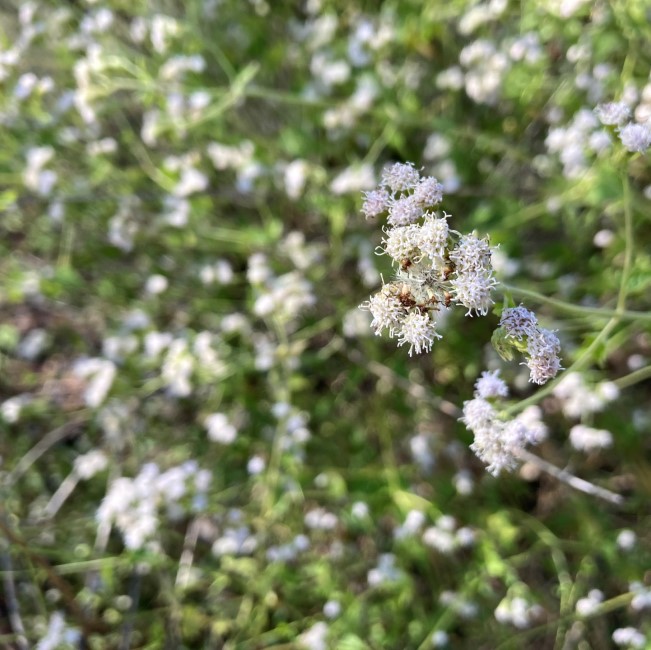Take a good gander. Chances are you’ll spot these prolific happy little flowers blooming somewhere near you.
One of the most widespread and successful plant families is the aster family, Asteraceae. Many central Texas wildflowers belong to this family and many are a shade of purple.
In fact, there are so many different species growing wild and in landscapes throughout Bexar County that you can probably find one blooming near you any month of the year.
This is by no means an exhaustive list and many of the species highlighted here can be seen blooming at the same time. Look around each month to see if you spot any of these happy little flowers.
 January: Acourtia runcinate
January: Acourtia runcinate
Featherleaf desert peony (Acourtia runcinate) is a surprisingly common but shy aster. To find them in the wild seek it out hiding under dense brush or perched up high on limestone cliffs. The leaves are distinctive, resembling prickly dandelion leaves, and they can be seen blooming any month of the year so long as temperature and moisture allow. This would be a great addition to any shady residential garden.

February: Texas Thistle Cirsium texanum
Often maligned as a “weed,” this Texas thistle (Cirsium texanum) plays an oversized role in the ecosystem providing food for a wide range of wildlife. Silvery blue leaves, well-guarded by prickles, are surmounted by purple flowers from late winter through early summer.
 March: Gregg’s Mistflower Conoclinium greggii
March: Gregg’s Mistflower Conoclinium greggii
A favorite of monarch and queen butterflies (and therefore of gardeners), Gregg’s mistflower (Conocliunium greggii) is a local staple in landscapes across the county. It has a long blooming period starting in March and running through the end of the year as long as conditions allow.

April: Centaurea americana
American basketflower (Centaurea americana) looks like a thistle when in bloom but lacks the prickles on the leaves and stem. So named for its distinctive phyllaries this purple flower with a white center is a prolific bloomer throughout the spring and early summer. This annual is common along roadsides and is easy to grow from wildflower seed mixes.

May: Echinacea angustifolia
The purple coneflower (Echinacea purpurea) is more common in landscaping, but narrow leaf coneflower (Echinacea angustifolia) is the more drought tolerant and locally native species. It’s a personal favorite of mine even if the petals are more rosy than true purple.

June: Woolly Ironweed Vernonia lindheimeri
As summer begins to heat up ironweeds start to take off. Woolly ironweed (Vernonia lindheimeri) is most commonly found growing wild in the rocky soils of the Texas Hill Country, but the striking purple flowers look great contrasting with silvery foliage in home landscapes as well.

July: Lygodesmia texana
If you can brave the summer heat, you might catch a glimpse of Texas skeleton plant (Lygodesmia texana). As a water-saving strategy this plant lacks leaves retaining only the skeleton of the plant — the stems — for photosynthesis.

August: Pluchea odorata
If you decide to tube down a Hill Country river keep an eye out for marsh fleabane (Pluchea odorata). As the name suggests, this plant likes to grow in the marshy areas near rivers and creeks and blooms throughout the summer.

September: Palafoxia callosa
As summer wears on and everyone is about ready to quit, there’s one tiny plant — small palafoxia (Palafoxia callosa) — that’s just getting started. These wispy plants have been growing in the background since spring but don’t produce their pink/purple flowers until the first sporadic rains in September. They’ll continue to bloom in the rocky soils of the Hill Country until the first frosts of winter.

October: Liatris Punctata
Gay feather (Liatris punctata) is the herald of fall in the Hill Country. Masses of purple flowers spring to life just as the monarchs start flying through to Mexico. This is one of the many under-utilized drought tolerant native plants that play an oversized role in the ecosystem and would look great in residential landscapes.

November: Symphyotrichum oblongifolium
Fall aster (Symphyotrichum oblongifolium) is a consistent fall bloomer that produces masses of purple flowers in November. Mostly found in landscaping, this plant is rare to find in natural settings around Bexar County.

December: Fleischmannia incarnata
This plant might be a bit of a cheat, but it’s a personal favorite of mine, so I’m including it anyway. The local populations of pink thoroughwort (Fleischmannia incarnata) produce flowers that are mostly white, but some individuals have a pinkish or purplish tint. Most importantly, it blooms pretty much all winter long, especially when protected from frosts by the brush it usually grows up through.


